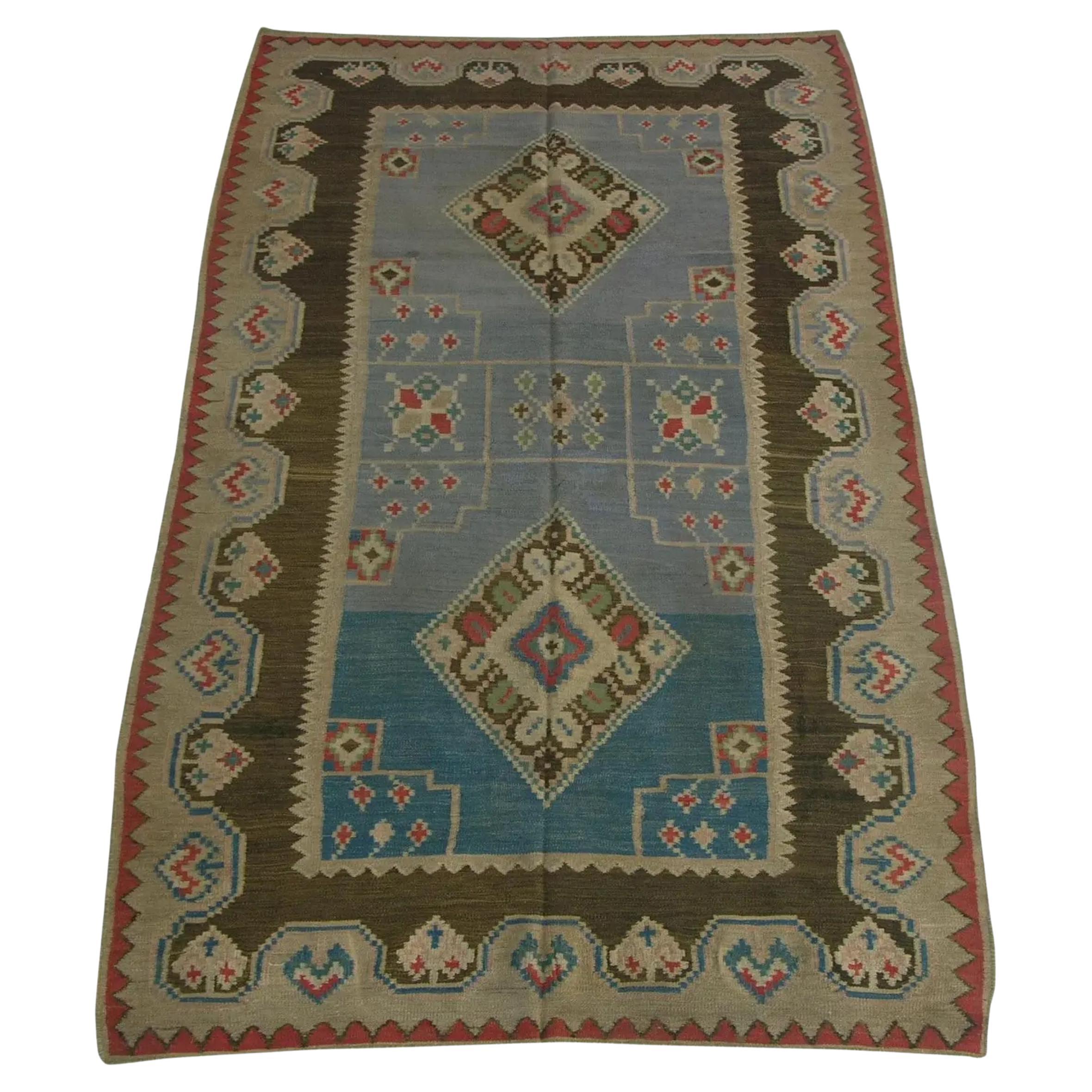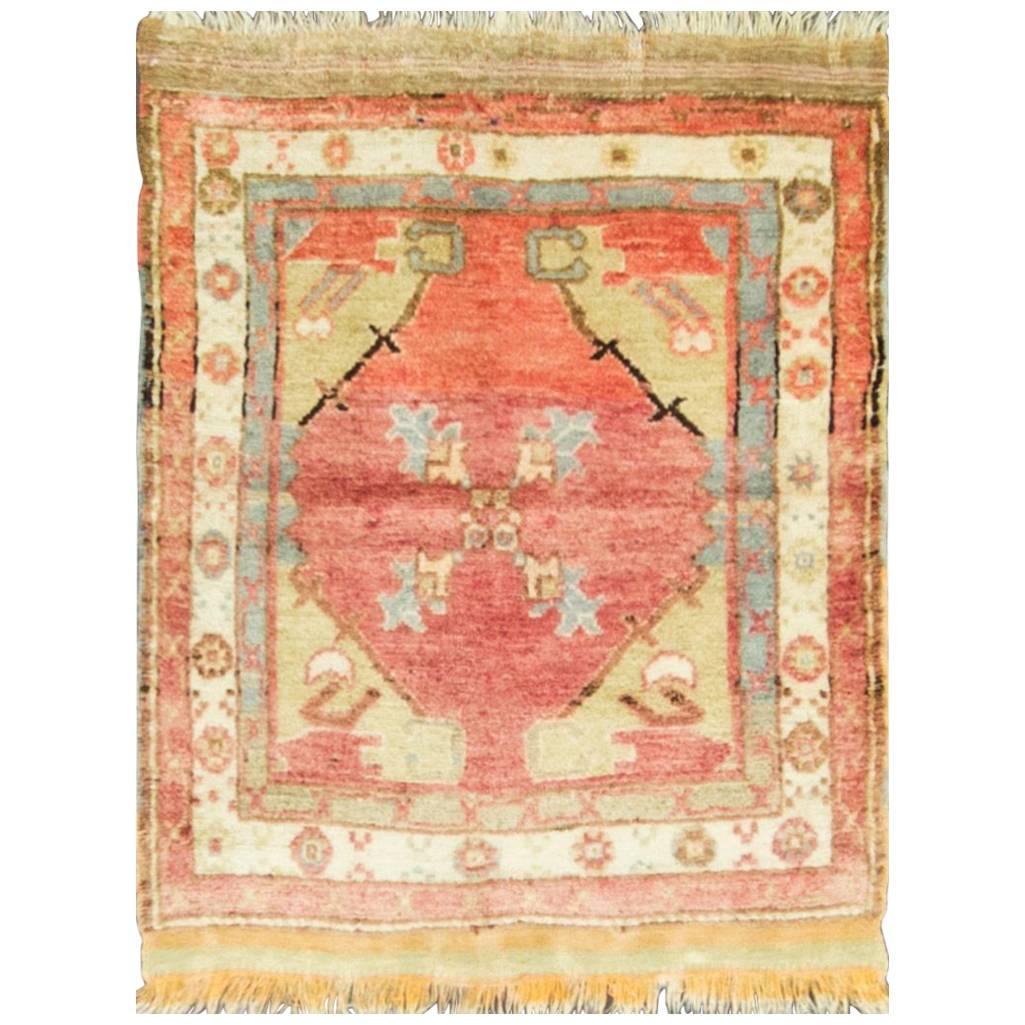Items Similar to Ca.1880 Antique Collectible Savonnerie Rug 6'1'' X 3'4''
Want more images or videos?
Request additional images or videos from the seller
1 of 5
Ca.1880 Antique Collectible Savonnerie Rug 6'1'' X 3'4''
About the Item
Savonnerie Carpets – During the early seventeenth century, a weaver named Pierre DuPont traveled to the Levant. Upon his return, he claimed to have discovered the technique of creating Turkish rugs. Oriental rugs were extremely expensive during Bourbon times, and a French manufactory that could create the same type of rug would lower the price significantly. Henri VI of France–the reigning monarch at the time–took advantage of DuPont’s skills and established a workshop for him at the Louvre. In 1627, King Louis XIII founded a manufactory for DuPont and his apprentice, Simon Lourdet, on the site of a defunct soap factory in the sixteenth arrondissement (also known as Quai de Chaillot). The name “Savonnerie” was born from the French word “savon” meaning “soap.” DuPont and Lourdet worked together, weaving rugs under a royal patent for the king and other nobles, until they had a falling out and split up. Lourdet remained at the Chaillot location while DuPont went to his workshops in the Louvre, though both continued to make Savonnerie rugs.
DuPont’s discovery was an ancient weaving technique called the Ghiordes knot. The Ghiordes is the oldest known knot used in carpet production. It consists of a symmetrical structure achieved by passing a single weft yarn over two warp yarns, pulling through between before severing the yarn to create the pile. The Ghiordes knot is characteristic of Turkish rugs. This weaving technique created a more durable structure than the tapestries created by European weavers. Tapestries were hung on walls, while the Turkish style French rugs were sturdy enough for foot traffic.
When Louis XVI came to the French throne in 1643, he was a mere five years old, but in 1659 he began a phase of renovations for the Palais de Louvre, at which he commissioned 274 carpets — all of a length of twenty-nine feet with varying widths–from the Savonnerie manufactory. The process was grueling and did not end until 1697 when the final carpet for the Louvre was woven. His favorite artist, Charles Le Brun, drew up cartoons of rug designs for the Louvre’s Grande Galerie. The designs consisted of a dark-colored background, filled with motifs of scrolls, cornucopias, flowers, arms of France, and the monogram of Louis. Inventories of Louis’ possessions show that in the early years of his reign, he had a number of Turkish and Persian rugs, though they were gradually superseded by Savonnerie carpets. At the same time, King Louis was hard at work supervising the construction of his grand new palace at Versailles, and he moved his residence at the Louvre for Versailles in 1678.
Savonnerie carpets also served as grand diplomatic gifts from Louis to foreign ambassadors and other notables. He gifted a collection of music-themed Savonnerie creations to the ambassador of Siam, where they stayed intact and in use for hundreds of years.
The legacy of the Savonnerie manufactory was a great one. The carpets remained the exclusive property of the French rulers until 1768. In the same century, the classic Savonnerie designs were updated with lighter, brighter colors and Rococo elements. The production of Savonnerie rugs declined in the latter half of the eighteenth century, until 1805 when the designs were revived by Napoleon. Twenty years later, the Savonnerie workshop merged with the Gobelins tapestry manufactory. This marked the end of its independence, though the production was ever steady. A number of the first Savonnerie designs still exist today, having survived the Fronde, the French Revolution, and two World Wars. They have avoided going out of fashion by reinventing themselves from Louis XIV style to Rococo to French Empire to Art Deco and beyond.
Antique French Savonnerie rugs exemplify the formal grace and elegance of classical European design. Like Aubusson tapestry rugs, Savonneries originated in France when European taste turned away for a time from Oriental carpets in the later eighteenth and earlier nineteenth centuries. Named for nearby factories that produced soap or “savon,” Savonnerie rugs shared with Aubussons a Neo-Classical taste for naturalistic flowers and swags or garlands in soft colors on a dominant ivory field, except that they were made in knotted pile rather than tapestry technique. Later, carpets of this kind were made in other European centers, most notably in Spain.
- Dimensions:Width: 40 in (101.6 cm)Length: 73 in (185.42 cm)
- Style:Empire (In the Style Of)
- Materials and Techniques:
- Place of Origin:
- Period:
- Date of Manufacture:1880
- Condition:
- Seller Location:Los Angeles, US
- Reference Number:
About the Seller
5.0
Gold Seller
These expertly vetted sellers are highly rated and consistently exceed customer expectations.
Established in 1920
1stDibs seller since 2023
27 sales on 1stDibs
Typical response time: <1 hour
- ShippingRetrieving quote...Ships From: Los Angeles, US
- Return PolicyA return for this item may be initiated within 3 days of delivery.
More From This SellerView All
- Antique Kilim Geometric Design Rug 10' X 6'1''Located in Los Angeles, USAntique rugs that are called “Kilim rugs”, primarily refer to a type of flat weave rug that was produced without knotted pile. Because these antique rugs are found across the globe, each region has a different pronunciation and spelling of the name Kilim. Homers Iliad and Egyptian tomb paintings, from the same time period, depict weavers producing rugs and carpets of this kind. Since this is one of the oldest methods of rug production, it is considered to be primitive...Category
Antique Early 1900s Kilim Turkish Rugs
MaterialsWool, Cotton
- Antique Kilim Geometric Design Rug 10' X 6'1'Located in Los Angeles, USAntique Bessarabian Rugs / Kilims in both pile and tapestry weaving technique are some of the more beautiful carpets to have been produced in Europe. Many of the Bessarabian Kilims w...Category
Antique Early 1900s Kilim Turkish Rugs
MaterialsWool, Cotton
- Ca.1880 Antique Turkish Oushak Floral Design Rug 8' X 8'4''Located in Los Angeles, USAntique Turkish Oushak rugs have been woven in Western Turkey since the beginning of the Ottoman period. Historians attributed to them many of the great masterpieces of early Turkish...Category
Antique 19th Century Oushak Turkish Rugs
MaterialsWool, Cotton
- 1900s Antique Turkish Prayer RugLocated in Los Angeles, US1900s Antique Turkish Prayer Rug, handmade and hand-knottedCategory
Antique Late 19th Century Turkish Empire Turkish Rugs
MaterialsWool, Cotton
- Antique Turkish Oushak Floral Rug 10'x7'10''Located in Los Angeles, USAntique Turkish Oushak Floral Design 10'x7'10''Category
Antique Early 1900s Turkish Empire Turkish Rugs
MaterialsWool, Cotton
- 1850s Antique Silk Turkish Floral Rug 12'x9'Located in Los Angeles, USCa.1850 Antique Silk Turkish Rug Floral Design 12'x9'Category
Antique 1850s Turkish Empire Turkish Rugs
MaterialsWool, Cotton
You May Also Like
- Vintage Turkish Oushak Rug Runner 3'4 x 6'1Located in New York, NYVintage Turkish Oushak rug runner, 3'4' x 6'1'. Oushak's are known for their soft palettes combined with eccentric drawing. Oushak in western Turkey has the longest continuous rug we...Category
20th Century Turkish Oushak Turkish Rugs
MaterialsWool
- Handmade Antique Collectible Turkish Transylvania Rug, 1880s, 1P129Located in Bordeaux, FRHandmade antique Turkish Transylvania prayer rug in bright natural dyes. The rug is from the end of 19th century in original good condition. -condition: original good, -circa: ...Category
Antique 1880s Turkish Turkish Rugs
MaterialsWool
- Handmade Antique Collectible Turkish Yastik Rug, 1880s, 1B349Located in Bordeaux, FRThis Turkish Yastik has very rare design of Persian Khamseh rug. Same geometric style and shapes. Even the colors of chocolate brown, blue, beige and red which they used on it are mo...Category
Antique Late 19th Century Turkish Turkish Rugs
MaterialsWool
- Antique Turkish Oushak Sampler Rug 2'8" x 3'4".Located in Evanston, ILUshak rugs have been in production since the 15th century with superb wool and natural dyes. Unlike other Turkish rugs, Ushak rugs influenced after Persian rugs and the woven with Gh...Category
Early 20th Century Turkish Oushak Turkish Rugs
MaterialsWool
- Antique Hand-knotted Turkish Ghiordes 'Gordes' Prayer Rug, Ca 1880Located in Philadelphia, PAAn antique Turkish Ghiordes prayer rug hand-knotted in 1880s in Gordes of Western Turkey, which was once a famous rug making centre with its own well-defined classical aesthetic. T...Category
Antique Late 19th Century Turkish Oushak Turkish Rugs
MaterialsWool
- Handmade Vintage Turkish Rug 4'x 6'1"By Asian ModernLocated in Houston, TXIntroducing a one-of-a-kind vintage Turkish hand-knotted wool rug, carefully crafted by skilled artisans using traditional techniques passed down through generations. This exquisite ...Category
Vintage 1960s Turkish Tribal Turkish Rugs
MaterialsWool





